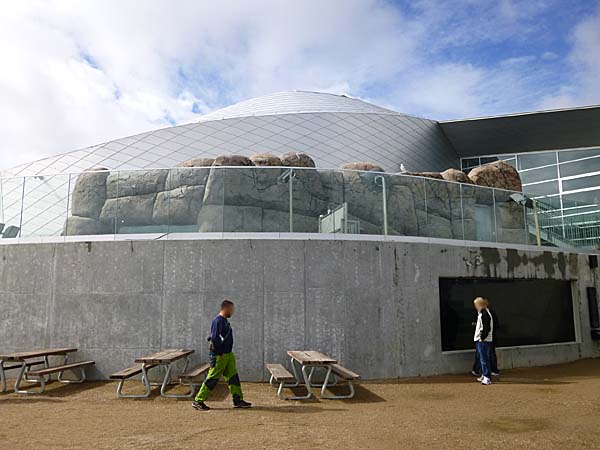| Architect |
3XN |
| Date
Built |
2013 |
| Location |
Kastrup |
| Description |
|
|
Blue Planet is a
dramatic new aquarium building on the
coast of Denmark in the Kastrup suburb of
Copenhagen. The building is close to
Copenhagen airport and looks out over the
Øresund and the fixed link joining Denmark
to Sweden. The architect explains
that the building is clad in, " ...
small diamond-shaped aluminium plates,
known as shingles, which adapts to the
building's organic form. Just as water
aluminium reflects the colours and
light of the sky and thus the
buildings expression varies with the
changes in its natural surroundings."
The shape of the building, as seen from
above, was inspired by, " ... the
whirl streams of the sea, shoals of
fish, and swirling starlings turning
the sky black."
  The aquarium says
that, " ... From the entrance, the
visitor steps into the vortex of the
whirlpool – the round lobby – and is
drawn inside the spiral towards the
53 aquariums and installations." 3XN
add that their intention was to
create a design that pulled the
visitors into, "... another world -
a world beneath the surface of the
sea. ... The circular foyer is
the central point of navigation in
the aquarium. Here visitors choose
which river, lake or ocean to
explore. By enabling multiple routes
the risk of queues in front of
individual aquariums is reduced."
An article in World
Architecture News focused on 3XN's
building points out that, "Like
watery currents, the building is not
static – the movement continues into
the future by virtue of always
allowing possible extensions to add
more, simply by letting the lines of
the whirlpool grow further out. Any
expansion would cause a minimum of
inconvenience to the contemporary
exhibitions and the existing parts
of the building. The extensions can
simply be added to an individual
arm, solely closing this particular
section down during the extension
process and not re-opening it until
completion. Secondly, the key
element is that any new building
volumes added will be extensions of
the architecture, with any expansion
of the aquarium simply taking place
in a natural dialogue with the
building itself."
|
|
Blue Planet,
Kastrup, Denmark           Close Window  |